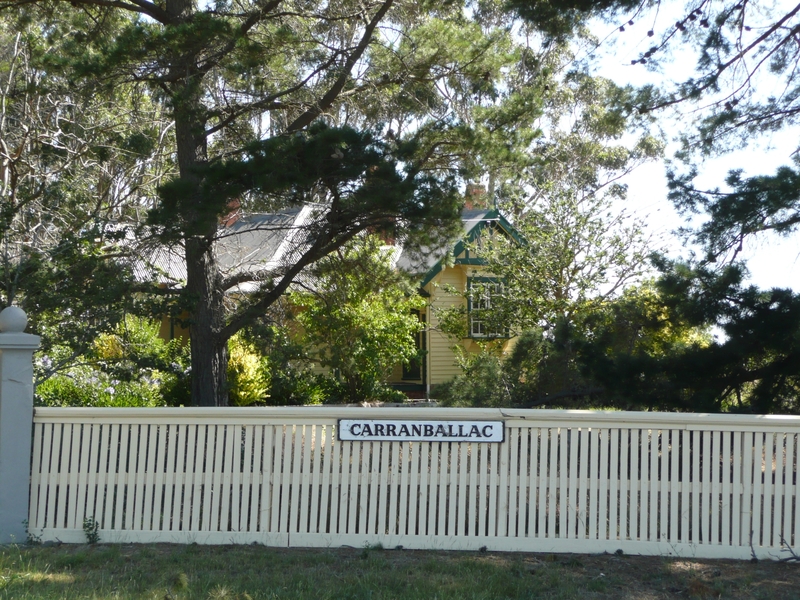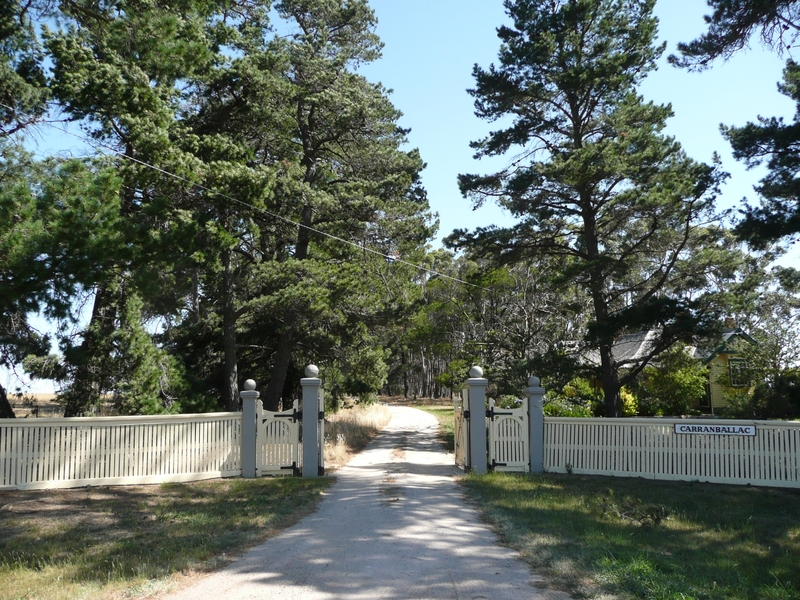CARRANBALLAC
5945 GLENELG HIGHWAY CARRANBALLAC, PYRENEES SHIRE
-
Add to tour
You must log in to do that.
-
Share
-
Shortlist place
You must log in to do that.
- Download report



Statement of Significance
What is significant?
The large station property Carranballac, Skipton, was settled by the pastoralist Andrew Chirnside, who arrived in Australia from Scotland in 1841. With his brother Thomas, Andrew prospered and together they established themselves as one of the leading pastoral families of the colony of Victoria. By 1870 they owned about 250,000 acres of freehold land in the State. Carranballac was their home station in Victoria's Western District, run as a highly successful sheep station, and also home to a successful horse stud, begun as early as 1865. Five generations of the Chirnside family lived there until 1987.
The Chirnside brothers acquired a chain of runs in the Western District of Victoria, including Carranballac, where they purchased the right of run of 26,540 acres in 1854. Andrew and Mary Chirnside settled at Carranballac while Thomas and his family settled at Werribee Park, Wyndham (VHR H1613). In 1882 about 50,000 acres at Carranballac were transferred to Andrew's son Robert, and he and his wife resided there from 1885 until Robert's death in 1900. His son Gordon then managed the property from 1908, purchasing 15,448 acres of land in 1909 and selling the remainder. He lived at Carranballac until 1953 when he sold portions to his sons, with Robert taking over the homestead portion.
A large, simple L-shaped bluestone homestead with slate roof was constructed in the mid-1860s, replacing accommodation provided in an earlier timber building and stone cottages. Dating from the 1840s and 1850s, these earlier buildings were retained and used as service facilities. Alterations and additions were made to the 1860s homestead, including decorative cast iron work added to the verandah in the 1880s. Redecoration undertaken in the early 1900s included the installation of an extensive Art Nouveau style fireplace mantel and surround.
Many ancillary buildings which were constructed at Carranballac during the Chirnside family occupancy remain on the site. Generally built of bluestone and roofed in slate or iron over blackwood shingles, these include an octagonal dairy, powder magazine, men's hut, stables and wool shed. The stables, probably dating from the late 1850s, were altered in 1910 to accommodate a large garage and workshop for vehicles. The whole building was rendered and a timber clock tower erected above. The 22-stand woolshed, probably built from c1852 with subsequent extensions, was mechanised in the 1880s with the early installation of the newly developed Wolseley shearing machines.
An hydro-electric scheme was constructed by Gordon Chirnside who rapidly mechanised the property after acquiring it in 1909. In 1919, at great cost, he had a weir constructed across Mt Emu Creek and an associated power house built to supply hydro-electric power to the woolshed and homestead.
How is it significant?
Carranballac, Skipton is of historical, architectural and scientific (technical) significance to the State of Victoria.
Why is it significant?
Carranballac, Skipton is of historical significance for its association with the leading Victorian pastoral family, the Chirnsides, who founded the most extensive pastoral empire in the colony of Victoria. Developed by the family from the 1850s, and owned by five generations for over 130 years, it epitomises the pastoral era in Victoria.
Carranballac, Skipton is of architectural significance as an unpretentious but extensive group of station buildings, illustrative of the activities undertaken at the property. These include the homestead, woolshed and shearers' hut, stables, dairy, powder magazine and men's hut.
Carranballac, Skipton is of scientific (technical) significance for its highly sophisticated hydro-electric scheme, constructed in 1919 to increase the self sufficiency of the property. It is also of significance for its early mechanization of the woolshed in the 1880s, reportedly with one of the first installations of Wolseley shearing machines. These were developed by Frederick Wolseley from the early 1870s and were first used for a complete shearing in N.S.W. in 1888.
[Online Data Upgrade Project 2007]
-
-
CARRANBALLAC - History
The large station property Carranballac, Skipton, was settled by the pastoralist Andrew Chirnside, who arrived in Australia from Scotland in 1839. With his brother Thomas, Andrew prospered and together they established themselves as one of the leading pastoral families of the colony of Victoria. By 1870 they owned about 250,000 acres of freehold land in the State. Carranballac was their home station in Victoria's Western District, run as a highly successful sheep station, and also home to a successful horse stud, begun as early as 1865. Five generations of the Chirnside family lived there until 1987.
The Chirnside brothers acquired a chain of runs in the Western District of Victoria, including Carranballac, where they purchased the right of run of 26,540 acres in 1854. Andrew and Mary Chirnside settled at Carranballac while Thomas and his family settled at Werribee Park, Wyndham (VHR H1613). In 1882 about 50,000 acres at Carranballac were transferred to Andrew's son Robert, and he and his wife resided there from 1885 until Robert's death in 1900. His son Gordon then managed the property from 1908, purchasing 15,448 acres of land in 1909 and selling the remainder. He lived at Carranballac until 1953 when he sold portions to his sons, with Robert taking over the homestead portion.
The draft statement of significance and the above history were produced as part of an Online Data Upgrade Project 2007. Sources were as follows:
H. Ronald. Wool Past the Winning Post: a history of the Chirnside family. South Yarra 1978
Carranballac - gathered memories 1841-1988. 1988
CARRANBALLAC - Permit Exemptions
General Exemptions:General exemptions apply to all places and objects included in the Victorian Heritage Register (VHR). General exemptions have been designed to allow everyday activities, maintenance and changes to your property, which don’t harm its cultural heritage significance, to proceed without the need to obtain approvals under the Heritage Act 2017.Places of worship: In some circumstances, you can alter a place of worship to accommodate religious practices without a permit, but you must notify the Executive Director of Heritage Victoria before you start the works or activities at least 20 business days before the works or activities are to commence.Subdivision/consolidation: Permit exemptions exist for some subdivisions and consolidations. If the subdivision or consolidation is in accordance with a planning permit granted under Part 4 of the Planning and Environment Act 1987 and the application for the planning permit was referred to the Executive Director of Heritage Victoria as a determining referral authority, a permit is not required.Specific exemptions may also apply to your registered place or object. If applicable, these are listed below. Specific exemptions are tailored to the conservation and management needs of an individual registered place or object and set out works and activities that are exempt from the requirements of a permit. Specific exemptions prevail if they conflict with general exemptions. Find out more about heritage permit exemptions here.Specific Exemptions:General Conditions: 1. All exempted alterations are to be planned and carried out in a manner which prevents damage to the fabric of the registered place or object. General Conditions: 2. Should it become apparent during further inspection or the carrying out of works that original or previously hidden or inaccessible details of the place or object are revealed which relate to the significance of the place or object, then the exemption covering such works shall cease and Heritage Victoria shall be notified as soon as possible. Note: All archaeological places have the potential to contain significant sub-surface artefacts and other remains. In most cases it will be necessary to obtain approval from the Executive Director, Heritage Victoria before the undertaking any works that have a significant sub-surface component.General Conditions: 3. If there is a conservation policy and planall works shall be in accordance with it. Note:A Conservation Management Plan or a Heritage Action Plan provides guidance for the management of the heritage values associated with the site. It may not be necessary to obtain a heritage permit for certain works specified in the management plan.
General Conditions: 4. Nothing in this determination prevents the Executive Director from amending or rescinding all or any of the permit exemptions. General Conditions: 5. Nothing in this determination exempts owners or their agents from the responsibility to seek relevant planning or building permits from the responsible authorities where applicable. Minor Works : Note: Any Minor Works that in the opinion of the Executive Director will not adversely affect the heritage significance of the place may be exempt from the permit requirements of the Heritage Act. A person proposing to undertake minor works must submit a proposal to the Executive Director. If the Executive Director is satisfied that the proposed works will not adversely affect the heritage values of the site, the applicant may be exempted from the requirement to obtain a heritage permit. If an applicant is uncertain whether a heritage permit is required, it is recommended that the permits co-ordinator be contacted.
-
-
-
-
-
CARRANBALLAC
 Victorian Heritage Register H0424
Victorian Heritage Register H0424
-
3 Sherwood Street
 Yarra City
Yarra City -
Archaeological site
 Southern Grampians Shire
Southern Grampians Shire -
BLACKWOOD HOMESTEAD COMPLEX AND CEMETERY
 Southern Grampians Shire
Southern Grampians Shire
-
-










